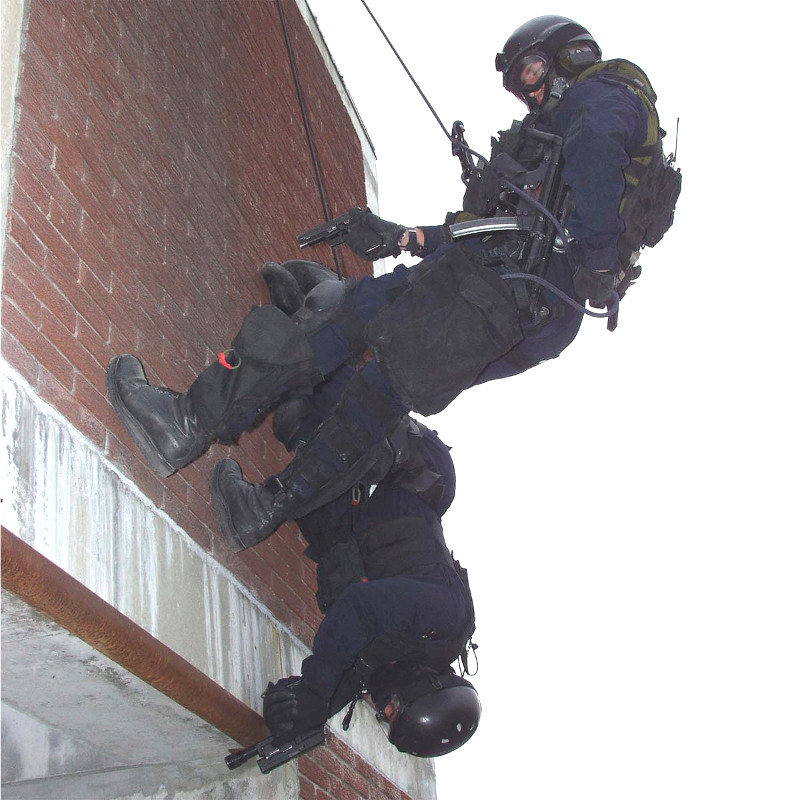Most countries are tight-lipped about their special operations forces, and their activities. Canada, which has a very active group of elite units conducting sensitive missions at home and abroad, is no exception.
So it was a pleasant surprise when the Canadian Forces’ official Twitter account posted a number of unusual pictures from the very early days of the country’s secretive Joint Task Force 2 (JTF 2) on March 10, 2017. This is the country’s “Tier One” force, equivalent to the U.S. Army’s Delta Force or the U.S. Navy’s SEAL Team Six.
The four photographs show operators training to rappel from CH-146 Griffon helicopters and down the side of a building, assaulting a mock suspect vehicle and stacking up outside a building. They wear blue uniforms and have only a limited amount of gear, while carrying an assortment of regular and suppressed 9mm Heckler and Koch MP5 submachine guns with red-dot sights and Sig-Sauer pistols with flashlights underneath the muzzle.
All in all, the troops look more like a police-style special weapons and tactics (SWAT) team than a military organization. This reflects the unit’s very early history and origins.

“By the early 1990s, the continuing efforts of the Federal government to combat its enormous deficit led to continuing deep budget cuts to all government departments,” Canadian Army Col. Bernd Horn, who served as deputy commander of Canadian Special Operations Forces Command (CANSOFCOM), wrote in a 2012 monograph for the U.S. Joint Special Operations University.
“Faced with financial constraints, the requirement to pay overtime to members of the SERT – a force that had been in existence for years but had not yet deployed – as well as the requirement to continually rely on military airlift and other support provided the impetus for change,” he continued. “Moreover, the military in the post-Cold War era was also amenable to taking on new roles.”

SERT members trained the first JTF 2 cadres and the task force became officially operational on April 1, 1992. Two years later, Canadian military officials decided to transition the troops from a pure counter-terrorism focus to a broader special operations role.
More recent photos and video depict a more traditional-looking special operations element, with troops wearing camouflage uniforms, extensive web gear and other equipment and carrying 5.56mm M4-style carbines, sniper rifles, light machine guns, and grenade launchers. The official JTF-2 website has an image gallery consisting entirely promotional shots highlighting the various specific duties within the task force, from “medical technical” to “assaulter. Still, some operators appear to still be wearing SWAT-style solid green uniforms.

And though their existence is now a public fact, Canadian authorities have done done their utmost to keep the unit out of the public eye. When officials in Ottawa had announced the JTF 2 was in Afghanistan fighting Al Qaeda and the Taliban in October 2001, “the revelation came as a shock to most Canadians,” according to Horn. “Few actually knew that Canada possessed ‘commandos,’ or more accurately special operations forces.”
“We do what the Government asks of us, but please respect that we can’t tell everyone how we complete it,” the unit’s webpage says. As of 2017, JTF 2 still has a range of responsibilities inside the country and around the world.

Since its formation, JTF 2’s operators have deployed to Bosnia, Haiti, Afghanistan, and Iraq, as well as within Canada to help protect events like the 2010 Winter Olympics in Vancouver. In 2006, the Canadian Forces assigned the unit, along with the Canadian Special Operations Regiment (CSOR), the Canadian Joint Incident Response Unit (CJIRU), and 427 Special Operations Aviation Squadron (SOAS), to the newly formed CANSOFCOM.
But despite the task force’s history, for domestic counter-terrorism operations “you don’t use military force of that description unless you’ve exhausted what’s available in the law enforcement portfolio,” Maj. Gen. Michael Rouleau, then in charge of CANSOFCOM, told The Toronto Star in 2010. “We’re not first responders.”
More recently, in 2014, Canada sent members of CSOR to train and advise Kurdish forces in Northern Iraq as they fought Islamic State. Two years later, three CH-146s from 427 SOAS arrived in the city of Erbil to support the Canadian mission. We don’t know if the top secret JTF 2 has any operators in the fight against the brutal terrorist group, but it wouldn’t be surprising.
Contact the author: jtrevithickpr@gmail.com
